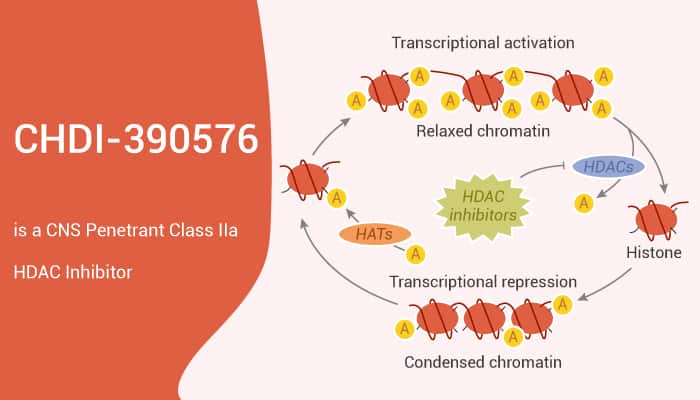Class IIa HDAC is a transcriptional corepressor enzyme. They interact with MEF2 transcription factors and the N-CoR, BCoR, and CtBP corepressors. They are capable of shuttling between the cytoplasm and nucleus, hence they are directly linked to cellular signaling networks. Class IIa HDACs found in a wide variety of biological processes. They play key roles in activity-dependent gene regulation. They respond to neural activity both in the CNS, heart, and at the neuromuscular junction. In addition, the therapeutic potential of HDAC4 inhibition is a therapeutic strategy to combat diverse indications. They include inflammatory hyperalgesia cardiac hypertrophy, certain cancers, muscle-wasting disorders. It also has therapeutic potential in progressive neurodegenerative diseases. In this study, CHDI-390576 is a potent, CNS penetrant class IIa HDAC inhibitor, with IC50s ranging from 31 to 60 nM for HDAC4, HDAC5, HDAC7, HDAC9.

CHDI-390576 is a potent, cell-permeable, and CNS penetrant class IIa HDAC inhibitor. The IC50s range from 31 to 60 nM for class IIa HDAC4, HDAC5, HDAC7, HDAC9. Moreover, it shows >500-fold selectivity over class I HDACs (1, 2, 3) and ~150-fold selectivity over HDAC8 and the class IIb HDAC6 isoform. It shows no significant effect on passive observations, responses to manipulations, body weight, or body temperature. CHDI-390576 causes a significant increase in open field measures of total and center distance in WT mice and in total and center rearing in both WT and R6/2 mice.
In summary, CHDI-390576 is a potent, cell-permeable, and CNS penetrant class IIa HDAC inhibitor. It shows >500-fold selectivity over class I HDACs (1, 2, 3) and ~150-fold selectivity over HDAC8 and the class IIb HDAC6 isoform.
Reference:
Luckhurst CA, et al. Bioorg Med Chem Lett. 2019 Jan 1;29(1):83-88.